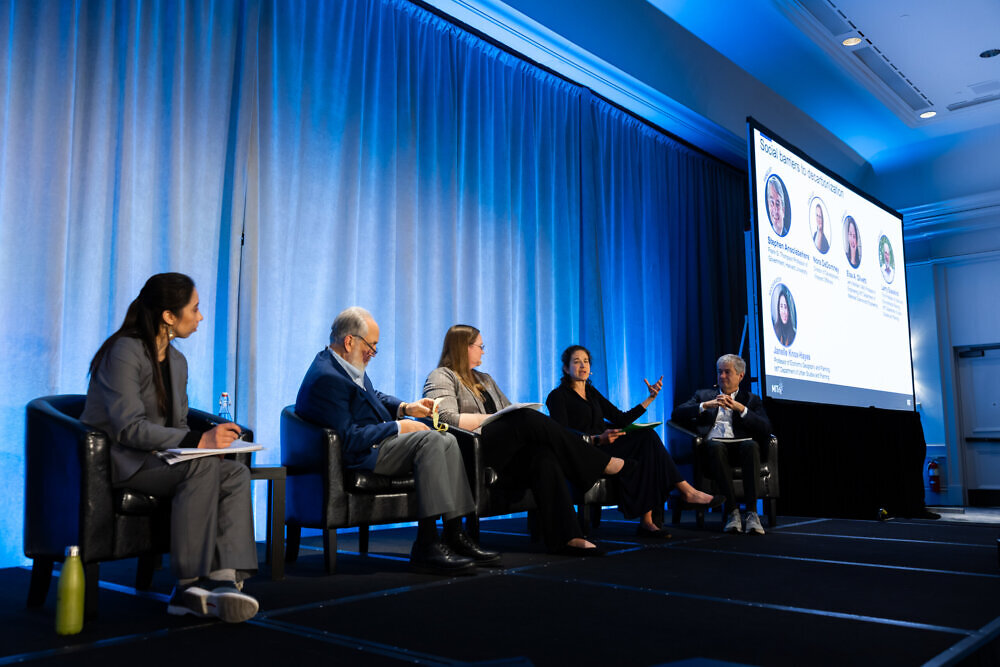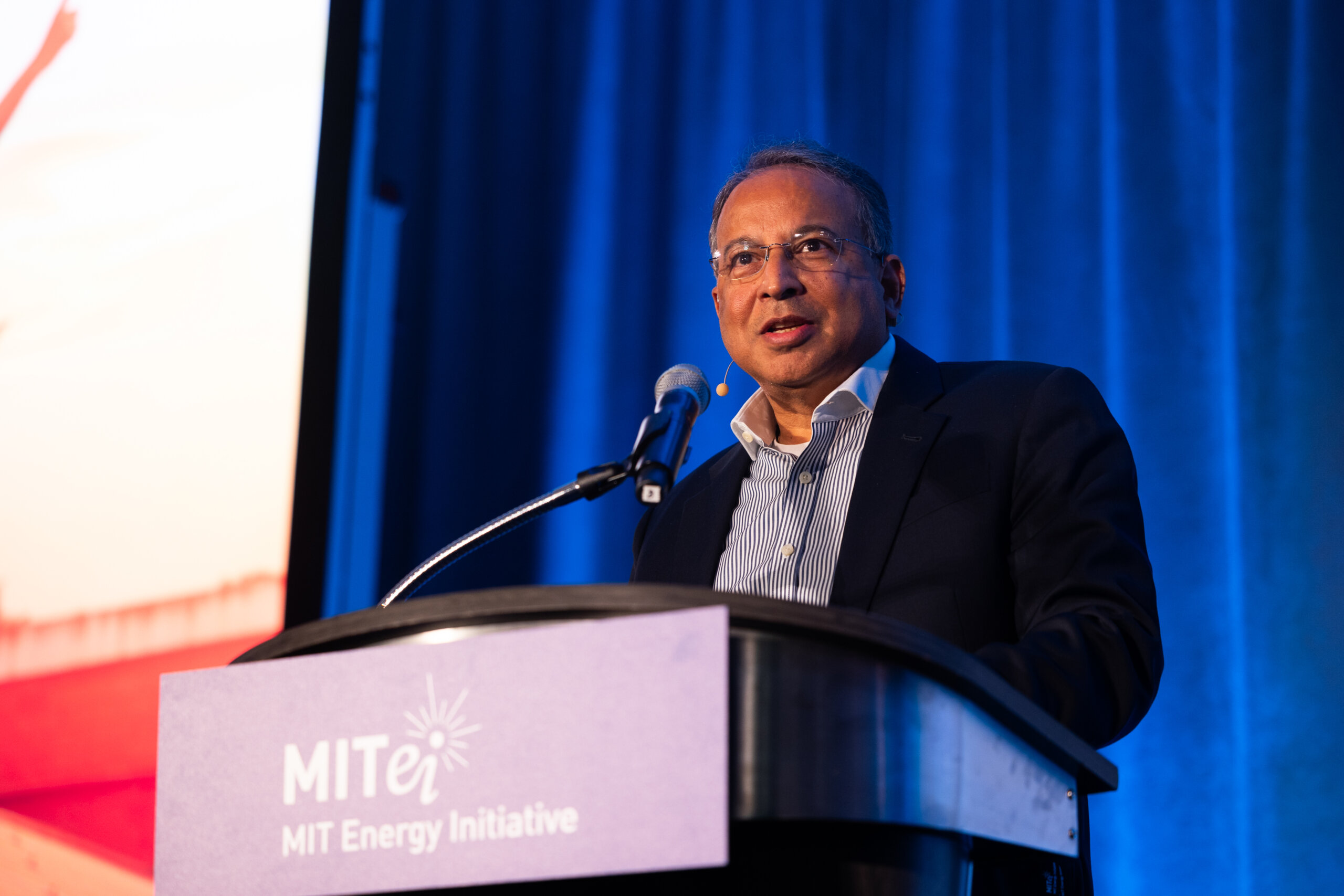
To fend off the worst impacts of climate change, “we have to decarbonize, and do it even faster,” said William H. Green, director of the MIT Energy Initiative (MITEI) and Hoyt C. Hottel Professor, MIT Department of Chemical Engineering, at MITEI’s Annual Research Conference.
“But how the heck do we actually achieve this goal when the United States is in the middle of a divisive election campaign, and globally, we’re facing all kinds of geopolitical conflicts, trade protectionism, weather disasters, increasing demand from developing countries building a middle class and data centers in countries like the U.S.?”
Researchers, government officials, and business leaders convened in Cambridge, MA on September 25th and 26th to wrestle with this vexing question at the conference that was themed, A durable energy transition: How to stay on track in the face of increasing demand and unpredictable obstacles.
“In this room we have a lot of power,” said Green, “if we work together, convey to all of society what we see as real pathways and policies to solve problems, and take collective action.”
The critical role of consensus building in driving the energy transition arose repeatedly in conference sessions, whether the topic involved developing and adopting new technologies, constructing and siting infrastructure, drafting and passing vital energy policies, or attracting and retaining a skilled workforce.
Resolving conflicts
There is “blowback and a social cost” in transitioning away from fossil fuels, said Stephen Ansolabehere, Frank G. Thompson Professor of Government at Harvard University, in a panel on the social barriers to decarbonization. “Companies need to engage differently and recognize the rights of communities,” he said.
Nora DeDontney, director of development at Vineyard Offshore, described her company’s two years of outreach and negotiations to bring large cables from ocean-based wind turbines onshore.
“Our motto is community first,” she said. Her company works to mitigate any impacts towns might feel because of offshore wind infrastructure construction with projects, such as sewer upgrades; provides workforce training to Tribal Nations; and lays out wind turbines in a manner that provides safe and reliable areas for local fisheries.
Elsa A. Olivetti, professor in the Department of Materials Science and Engineering at MIT and the lead of the Decarbonization Mission of MIT’s new Climate Project, discussed the urgent need for rapid scale-up of mineral extraction. “Estimates indicate that to electrify the vehicle fleet by 2050, about six new large copper mines need to come on line each year,” she said. To meet the demand for metals in the United States means pushing into indigenous lands and environmentally sensitive habitats. “The timeline of permitting is not aligned with the temporal acceleration needed,” she said.
Larry Susskind, Ford Professor of Urban and Environmental Planning in the MIT Department of Urban Studies and Planning, is trying to resolve such tensions with universities playing the role of mediators. He is creating renewable energy clinics where students train to participate in emerging disputes over siting. “Talk to people before decisions are made, conduct joint fact finding, so that facilities reduce harms and share the benefits,” he said.
Clean energy boom and pressure

Sean James (center), Senior Director of Datacenter Research at Microsoft, spoke on a panel discussing the challenges of decarbonizing data centers, especially regarding the energy demands of artificial intelligence. Credit: Jake Belcher
A relatively recent and unforeseen increase in demand for energy comes from data centers, which are being built by large technology companies for new offerings, such as artificial intelligence (AI).
“General energy demand was flat for 20 years—and now boom,” said Sean James, Microsoft’s senior director of data center research. “It caught utilities flatfooted.” With the expansion of AI, the rush to provision data centers with upwards of 35 gigawatts of new (and mainly renewable) power in the near future, intensifies pressure on big companies to balance the concerns of stakeholders across multiple domains. Google is pursuing 24/7 carbon-free energy by 2030, said Devon Swezey, the company’s senior manager for global energy and climate.
“We’re pursuing this by purchasing more and different types of clean energy locally, and accelerating technological innovation such as next-generation geothermal projects,” he said. Pedro Gómez Lopez, strategy and development director, Ferrovial Digital, which designs and constructs data centers, incorporates renewable energy into their projects, which contributes to decarbonization goals and benefits to locales where they are sited. “We can create a new supply of power, taking the heat generated by a data center to residences or industries in neighborhoods through District Heating initiatives,” he said.
The Inflation Reduction Act and other legislation has ramped up employment opportunities in clean energy nationwide, touching every region, including those most tied to fossil fuels, “At the start of 2024 there were about 3.5 million clean energy jobs, with “red” states showing the fastest growth in clean energy jobs,” said David S. Miller, managing partner at Clean Energy Ventures. “The majority (58%) of new jobs in energy are now in clean energy—that transition has happened. And 1 in 16 new jobs nationwide were in clean energy, with clean energy jobs growing more than three times faster than job growth economywide”
In this rapid expansion, the DOE is prioritizing economically marginalized places, according to Zoe Lipman, lead for good jobs and labor standards in the Office of Energy Jobs at the U.S. Department of Energy (DOE). “The community benefit process is integrated into our funding,” she said. “We are creating the foundation of a virtuous circle,” encouraging benefits to flow to disadvantaged and energy communities, spurring workforce training partnerships, and promoting well-paid union jobs. “These policies incentivize proactive community and labor engagement, and deliver community benefits, both of which are key to building support for technological change.”
Hydrogen opportunity and challenge
While engagement with stakeholders helps clear the path for implementation of technology and the spread of infrastructure, there remain enormous policy, scientific, and engineering challenges to solve, said multiple conference participants. In a “fireside chat,” Prasanna V. Joshi, vice president of low-carbon-solutions technology at ExxonMobil, and Ernest J. Moniz, professor of physics and special advisor to the president at MIT, discussed efforts to replace natural gas and coal with zero-carbon hydrogen in order to reduce greenhouse gas emissions in such major industries as steel and fertilizer manufacturing.
“We have gone into an era of industrial policy,” said Moniz, citing a new DOE program offering incentives to generate demand for hydrogen—more costly than conventional fossil fuels—in end-use applications. “We are going to have to transition from our current approach, which I would call carrots and twigs, to ultimately, carrots and sticks,” Moniz warned, in order to create “a self-sustaining, major, scalable, affordable hydrogen economy.”
To achieve net zero by 2050, ExxonMobil intends to use carbon capture and sequestration in natural gas-based hydrogen and ammonia production. Ammonia can also serve as a zero-carbon fuel. Industry is exploring burning ammonia directly in coal-fired power plants to extend the hydrogen value chain. But there are challenges. “How do you burn 100% ammonia?”, asked Joshi. “That’s one of the key technology breakthroughs that’s needed.” Joshi believes that collaboration with MIT’s “ecosystem of breakthrough innovation” will be essential to breaking logjams around the hydrogen and ammonia-based industries.
MIT ingenuity essential

In his keynote address, Praveer Sinha, CEO and Managing Director of The Tata Power Company Limited, described India’s energy transition and its response to rising energy demand. Credit: Jake Belcher
The energy transition is placing very different demands on different regions around the world. Take India, where today per capita power consumption is one of the lowest. But Indians “are an aspirational people…and with increasing urbanization and industrial activity, the growth in power demand is expected to triple by 2050,” said Praveer Sinha, CEO and managing director of the Tata Power Company Limited, in his keynote speech. For that nation, which currently relies on coal, the move to clean energy means bringing another 300 gigawatts of zero-carbon capacity online in the next five years. Sinha sees this power coming from wind, solar, and hydro, supplemented by nuclear energy.
“India plans to triple nuclear power generation capacity by 2032, and is focusing on advancing small modular reactors,” said Sinha. “The country also needs the rapid deployment of storage solutions to firm up the intermittent power.” The goal is to provide reliable electricity 24/7 to a population living both in large cities and in geographically remote villages, with the help of long-range transmission lines and local microgrids. “India’s energy transition will require innovative and affordable technology solutions, and there is no better place to go than MIT, where you have the best brains, startups, and technology,” he said.
These assets were on full display at the conference. Among them a cluster of young businesses, including:
- the MIT spinout, Form Energy, which has developed a 100-hour iron battery as a backstop to renewable energy sources in case of multi-day interruptions;
- startup Noya that aims for direct air capture of atmospheric CO2 using carbon-based materials;
- the firm Active Surfaces, with a lightweight material for putting solar photovoltaics in previously inaccessible places;
- Copernic Catalysts, with new chemistry for making ammonia and sustainable aviation fuel far more inexpensively than current processes; and
- Sesame Sustainability, a software platform spun out of MITEI that gives industries a full financial analysis of the costs and benefits of decarbonization.
The pipeline of research talent extended into the undergraduate ranks, with a conference “slam” competition showcasing students’ summer research projects in areas from carbon capture using enzymes to 3D design for the coils used in fusion energy confinement.
“MIT students like me are looking to be the next generation of energy leaders, looking for careers where we can apply our engineering skills to tackle exciting climate problems and make a tangible impact,” said Trent Lee, a junior in mechanical engineering researching improvements in lithium-ion energy storage. “We are stoked by the energy transition, because it’s not just the future, but our chance to build it.”